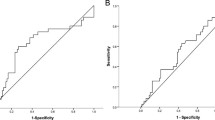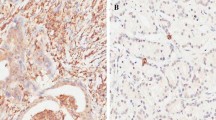Abstract
Purpose
To explore the clinical significance of Krüppel-like factors 4 (KLF4) expression in colorectal cancer initiation and progression.
Methods
We used quantitative real-time PCR to detect KLF4 mRNA expression in 49 colorectal cancer samples with individual-matched normal mucosa and eight concurrent adenomas. We also analysed the immunostaining pattern of KLF4 in additional 129 colorectal cancers and 48 sporadic colorectal adenomas with matched normal mucosa and correlated KLF4 staining with clinicopathological parameters and prognosis. KLF4 expression change was detected in SW480, SW620 and RKO cell lines after treatment of 5-aza-dC (10 μM) or butyrate sodium (4 mM).
Results
The large clinicopathlogical survey with combined methods confirmed a dynamic downregulation of KLF4 in individual-matched normal mucosa, adenoma and cancer (P < 0.05). The quantitative analysis of immunostaining pattern showed that KLF4 staining cells were more frequently seen in the upper zones than that in the lower zones of both normal mucosa and adenoma (P < 0.05). Survival analysis implied a trend toward better overall survival in KLF4-positive colorectal cancer patients with lymph node metastasis than that in KLF4-negative cancer with lymph node metastasis. In vitro study found elevated KLF4 mRNA expression in SW620 and RKO cells with 5-aza-dC treatment, implicating the underlying aberrant epigenetic modifications in regulating KLF4 expression at least in a subset of colorectal cancers.
Conclusions
KLF4 is associated with terminal differentiation in colorectal epithelium and drastically downregulated in colorectal adenomas and cancers via possible epigenetic modifications. Loss of KLF4 protein expression might contribute to assessing prognosis in colorectal cancer with lymph node metastasis.


Similar content being viewed by others
References
Chen C, Bhalala HV, Qiao H, Dong JT (2002) A possible tumor suppressor role of the KLF5 transcription factor in human breast cancer. Oncogene 21:6567–6572
Chen X, Whitney EM, Gao SY, Yang VW (2003) Transcriptional profiling of Kruppel-like factor 4 reveals a function in cell cycle regulation and epithelial differentiation. J Mol Biol 326:665–677
Chen ZY, Rex S, Tseng CC (2004) Kruppel-like factor 4 is transactivated by butyrate in colon cancer cells. J Nutr 134:792–798
Choi BJ, Cho YG, Song JW, Kim CJ, Kim SY, Nam SW, Yoo NJ, Lee JY, Park WS (2006) Altered expression of the KLF4 in colorectal cancers. Pathol Res Pract 202:585–589
Dang DT, Bachman KE, Mahatan CS, Dang LH, Giardiello FM, Yang VW (2000) Decreased expression of the gut-enriched Kruppel-like factor gene in intestinal adenomas of multiple intestinal neoplasia mice and in colonic adenomas of familial adenomatous polyposis patients. FEBS Lett 476:203–207
Fearon ER, Vogelstein B (1990) A genetic model for colorectal tumorigenesis. Cell 61:759–767
Foster KW, Frost AR, McKie-Bell P, Lin CY, Engler JA, Grizzle WE, Ruppert JM (2000) Increase of GKLF messenger RNA and protein expression during progression of breast cancer. Cancer Res 60:6488–6495
Garcia-Manero G, Kantarjian HM, Sanchez-Gonzalez B, Yang H, Rosner G, Verstovsek S, Rytting M, Wierda WG, Ravandi F, Koller C, Xiao L, Faderl S, Estrov Z, Cortes J, O’brien S, Estey E, Bueso-Ramos C, Fiorentino J, Jabbour E, Issa JP (2006) Phase 1/2 study of the combination of 5-aza-2’-deoxycytidine with valproic acid in patients with leukemia. Blood 108:3271–3279
Garrett-Sinha LA, Eberspaecher H, Seldin MF, de Crombrugghe B (1996) A gene for a novel zinc-finger protein expressed in differentiated epithelial cells and transiently in certain mesenchymal cells. J Biol Chem 271:31384–31390
Hamilton SR, Altonin LA (eds) (2000) World organization of tumours. Pathology and genetics: tumours of the digestive system. IARC Press, Lyon, pp 105–136
Jass JR (2007) Classification of colorectal cancer based on correlation of clinical, morphological and molecular features. Histopathology 50:113–130
Jass JR, Whitehall VL, Young J, Leggett BA (2002) Emerging concepts in colorectal neoplasia. Gastroenterology 123:862–876
Jemal A, Siegel R, Ward E, Murray T, Xu J, Smigal C, Thun MJ (2006) Cancer statistics, 2006. CA Cancer J Clin 56:106–130
Katz JP, Perreault N, Goldstein BG, Lee CS, Labosky PA, Yang VW, Kaestner KH (2002) The zinc-finger transcription factor Klf4 is required for terminal differentiation of goblet cells in the colon. Development 129:2619–2628
Konishi K, Yamochi T, Makino R, Kaneko K, Yamamoto T, Nozawa H, Katagiri A, Ito H, Nakayama K, Ota H, Mitamura K, Imawari M (2004) Molecular differences between sporadic serrated and conventional colorectal adenomas. Clin Cancer Res 10:3082–3090
Leake R, Barnes D, Pinder S, Ellis I, Anderson L, Anderson T, Adamson R, Rhodes T, Miller K, Walker R (2000) Immunohistochemical detection of steroid receptors in breast cancer: a working protocol. UK Receptor Group, UK NEQAS, The Scottish Breast Cancer Pathology Group, and The Receptor and Biomarker Study Group of the EORTC. J Clin Pathol 53:634–635
Lin J, Lai M, Huang Q, Ma Y, Cui J, Ruan W (2007) Methylation patterns of IGFBP7 in colon cancer cell lines are associated with levels of gene expression. J Pathol 212:83–90
Luo J, Dunn T, Ewing C, Sauvageot J, Chen Y, Trent J, Isaacs W (2002) Gene expression signature of benign prostatic hyperplasia revealed by cDNA microarray analysis. Prostate 51:189–200
Luo A, Kong J, Hu G, Liew CC, Xiong M, Wang X, Ji J, Wang T, Zhi H, Wu M, Liu Z (2004) Discovery of Ca2+-relevant and differentiation-associated genes downregulated in esophageal squamous cell carcinoma using cDNA microarray. Oncogene 23:1291–1299
Narla G, Heath KE, Reeves HL, Li D, Giono LE, Kimmelman AC, Glucksman MJ, Narla J, Eng FJ, Chan AM, Ferrari AC, Martignetti JA, Friedman SL (2001) KLF6, a candidate tumor suppressor gene mutated in prostate cancer. Science 294:2563–2566
Ohnishi S, Ohnami S, Laub F, Aoki K, Suzuki K, Kanai Y, Haga K, Asaka M, Ramirez F, Yoshida T (2003) Downregulation and growth inhibitory effect of epithelial-type Krüppel-like transcription factor KLF4, but not KLF5, in bladder cancer. Biochem Biophys Res Commun 308:251–256
Preston SL, Wong WM, Chan AO, Poulsom R, Jeffery R, Goodlad RA, Mandir N, Elia G, Novelli M, Bodmer WF, Tomlinson IP, Wright NA (2003) Bottom-up histogenesis of colorectal adenomas: origin in the monocryptal adenoma and initial expansion by crypt fission. Cancer Res 63:3819–3825
Qualtrough D, Hinoi T, Fearon E, Paraskeva C (2002) Expression of CDX2 in normal and neoplastic human colon tissue and during differentiation of an in vitro model system. Gut 51:184–190
Radtke F, Clevers H (2005) Self-renewal and cancer of the gut: two sides of a coin. Science 307:1904–1909
Schuh R, Aicher W, Gaul U, Cote S, Preiss A, Maier D, Seifert E, Nauber U, Schroder C, Kemler R (1986) A conserved family of nuclear proteins containing structural elements of the finger protein encoded by Kruppel, a Drosophila segmentation gene. Cell 47:1025–1032
Segre JA, Bauer C, Fuchs E (1999) Klf4 is a transcription factor required for establishing the barrier function of the skin. Nat Genet 22:356–360
Shie JL, Chen ZY, O’Brien MJ, Pestell RG, Lee ME, Tseng CC (2000) Role of gut-enriched Kruppel-like factor in colonic cell growth and differentiation. Am J Physiol Gastrointest Liver Physiol 279:806–814
Stone CD, Chen ZY, Tseng CC (2002) Gut-enriched Krüppel-like factor regulates colonic cell growth through APC/β-catenin pathway. FEBS Lett 530:147–152
Turner J, Crossley M (1999) Mammalian Kruppel-like transcription factors: more than just a pretty finger. Trends Biochem Sci 24:236–240
Ueno H, Murphy J, Jass JR, Mochizuki H, Talbot C (2002) Tumour ‘budding’ as an index to estimate the potential of aggressiveness in rectal cancer. Histopathology 40:127–132
Wani MA, Wert SE, Lingrel JB (1999) Lung Kruppel-like factor, a zinc finger transcription factor, is essential for normal lung development. J Biol Chem 274:21180–21185
Wei D, Gong W, Kanai M, Schlunk C, Wang L, Yao JC, Wu TT, Huang S, Xie K (2005) Drastic down-regulation of Krüppel-like factor 4 expression is critical in human gastric cancer development and progression. Cancer Res 65:2746–2754
Wei D, Kanai M, Huang S, Xie K (2006) Emerging role of KLF4 in human gastrointestinal cancer. Carcinogenesis 27:23–31
Zhao W, Hisamuddin IM, Nandan MO, Babbin BA, Lamb NE, Yang VW (2004) Identification of Krüppel-like factor 4 as a potential tumor suppressor gene in colorectal cancer. Oncogene 23:395–402
Acknowledgment
This manuscript was supported by a grant from the National Natural Science Foundation of China (no: 30371605).
Author information
Authors and Affiliations
Corresponding author
Rights and permissions
About this article
Cite this article
Xu, J., Lü, B., Xu, F. et al. Dynamic down-regulation of Krüppel-like factor 4 in colorectal adenoma-carcinoma sequence. J Cancer Res Clin Oncol 134, 891–898 (2008). https://doi.org/10.1007/s00432-008-0353-y
Received:
Accepted:
Published:
Issue Date:
DOI: https://doi.org/10.1007/s00432-008-0353-y




